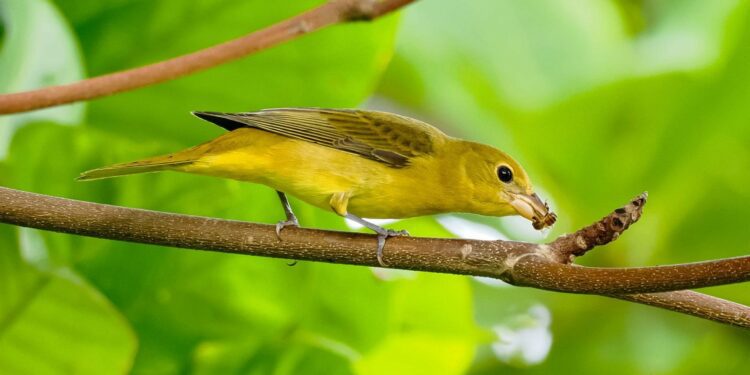With 100 resident bird species in the Cayman Islands and a further 150 migrant species passing through every year, birdwatchers are not short of birds to spot, but rarer birds tend to generate the most excitement as well as the kudos of being able to record the find in global bird-spotting database, eBird.
Recent new species sighted in Grand Cayman include the great crested flycatcher, the blackpoll warbler and the Mississippi kite, and even birds which are typically found far out to sea have been spotted taking refuge on land.
In spite of the abundance of birds on the islands, the resident bird-watching community barely makes it into double figures, but those that do it are passionate about their hobby.
тАЬI go out every weekend with a couple of friends,тАЭ says Kirkham. тАЬItтАЩs not only great for hiking but itтАЩs therapeutic, itтАЩs meditation and it gets me to parts of the island that I wouldnтАЩt necessarily have discovered.тАЭ
He admits that some birders can be highly competitive, but тАЬfor me, itтАЩs a personal passion. ItтАЩs exciting to find a new bird species, but I donтАЩt chase the numbers тАУ itтАЩs just fun.тАЭ
 Tonja Wight is a relative newcomer to birding and loves spotting new species. тАУ Photo: Supplied
Tonja Wight is a relative newcomer to birding and loves spotting new species. тАУ Photo: Supplied
Tonja Wight calls herself a novice, but in just three years of birdwatching she has already chalked up 171 different bird species.
тАЬI got into it during COVID, when I was stuck at my motherтАЩs home in Virginia,тАЭ she says. тАЬI started watching all the different birds which came to her bird feeder, and I said to my husband: тАШThis is what weтАЩre going to do when weтАЩre back home!’тАЭ
Tonja and her husband Philip, a keen photographer, now head out before sunrise most weekends to see what they can spot.
тАЬItтАЩs a good time of day because the birds are active and they sing a lot then too, so if you canтАЩt immediately see them, you can hear them,тАЭ she says.
 TonjaтАЩs nephew Oscar Kirkconnell out birdwatching. тАУ Photo: Tonja Wight
TonjaтАЩs nephew Oscar Kirkconnell out birdwatching. тАУ Photo: Tonja Wight
The couple has even got their nephews and nieces involved, including 12-year Oscar Kirkconnell, with the budding ornithologists quickly learning to spot birds by sight and song.
тАЬMost Caymanians know about five local birds and think thatтАЩs all we have,тАЭ she says. тАЬMy family were astonished when I told them how many bird species IтАЩd seen.тАЭ
While the resident bird-spotting community is small in number, that doesnтАЩt mean the Cayman Islands is off the birding map altogether. Holidaymakers with an interest in birdwatching will often leave the lure of the beach and head to popular spots like the Queen Elizabeth II┬аBotanic┬аPark to add to their personal list, or take a special birdwatching tour.
 The black-throated blue warbler is also a rare find on Grand Cayman but was seen here last week. тАУ Photo: Tonja Wight
The black-throated blue warbler is also a rare find on Grand Cayman but was seen here last week. тАУ Photo: Tonja Wight
Geddes Hislop, of Silver Thatch Excursions, has been running such tours since 1998 and says some visitors will even send him a list of species they hope to see in advance.
тАЬWe have many unique species here, such as the Cayman Islands parrot which isnтАЩt found anywhere else,тАЭ says Hislop. тАЬPeople who are members of birdwatching groups like the fact that theyтАЩll be able to go home and say theyтАЩve seen birds which no one else has.тАЭ
Source link : http://www.bing.com/news/apiclick.aspx?ref=FexRss&aid=&tid=6704cac23fe04de7a1aea9cc6cbf4c87&url=https%3A%2F%2Fwww.caymancompass.com%2F2024%2F09%2F28%2Frare-birds-flock-to-cayman-in-wake-of-hurricane-helene%2F&c=6759453413948796584&mkt=en-us
Author :
Publish date : 2024-09-27 18:01:00
Copyright for syndicated content belongs to the linked Source.












